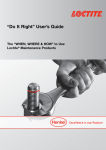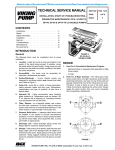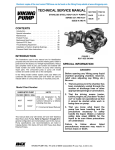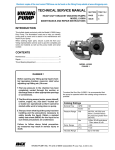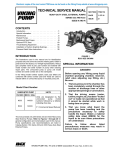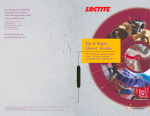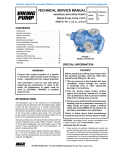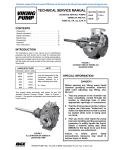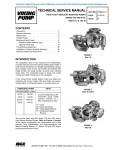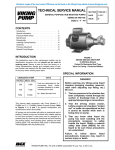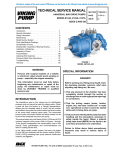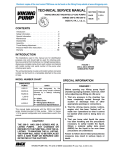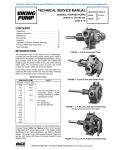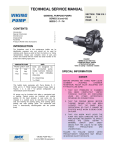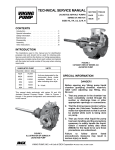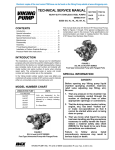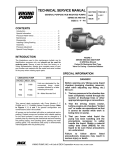Download Series 4195-G
Transcript
Electronic copies of the most current TSM issue can be found on the Viking Pump website at www.vikingpump.com TECHNICAL SERVICE MANUAL VIKING LP-GAS PUMPS SERIES 4195-G SIZES GG - AL SECTION TSM 442 PAGE 1 of 10 ISSUE C CONTENTS Introduction . . . . . . . . . . . . . . . . . . . . . . . .1 Safety Information . . . . . . . . . . . . . . . . . . . . 2 Special Information . . . . . . . . . . . . . . . . . . . .3 Maintenance . . . . . . . . . . . . . . . . . . . . . . .3 Disassembly . . . . . . . . . . . . . . . . . . . . . . .5 Assembly . . . . . . . . . . . . . . . . . . . . . . . . .6 Thrust Bearing Adjustment . . . . . . . . . . . . . . . .6 Pressure Relief Valve Instructions . . . . . . . . . . . 6 Supplementary Section . . . . . . . . . . . . . . . . . 8 Warranty . . . . . . . . . . . . . . . . . . . . . . . . 10 figure 1 - GG, HJ, HL 4195-G Unmounted pump INTRODUCTION The illustrations used in this manual are for identification purposes only and should not be used for ordering parts. Secure a parts list from the factory or a Viking® representative. Always give complete name of part, part number and material with model number and serial number of the pump when ordering repair parts. The unmounted pump or pump unit model number and serial number can be found on a nameplate attached to the pump or base. Model Number Chart UNMOUNTED PUMPS GG 4195-G HJ 4195-G HL 4195-G AS 4195-G AK 4195-G AL 4195-G UNITS Units are designated by the unmounted pump model numbers followed by a letter(s) indicating drive style. D = Direct Drive figure 2 - as, ak, al 4195-G Unmounted pump CAUTION ! This manual deals exclusively with the 4195-G Series LP-Gas pumps. Refer to Figures 1 thru 10 for general configuration and nomenclature used in this manual. The 4195-G series is a UL listed pump. Any changes or repairs to the pump will void the UL listing. To maintain the UL listing, the pump will need to be replaced with a new pump or repaired and retested at the factory. If the UL listing is no longer required, refer to TSM 144 for repair instructions. These can be obtained from your authorized Viking Pump distributor. VIKING PUMP, INC. • A Unit of IDEX Corporation • Cedar Falls, IA 50613 USA SAFETY INFORMATION AND INSTRUCTIONS IMPROPER INSTALLATION, OPERATION OR MAINTENANCE OF PUMP MAY CAUSE SERIOUS INJURY OR DEATH AND/OR RESULT IN DAMAGE TO PUMP AND/OR OTHER EQUIPMENT. VIKING’S WARRANTY DOES NOT COVER FAILURE DUE TO IMPROPER INSTALLATION, OPERATION OR MAINTENANCE. THIS INFORMATION MUST BE FULLY READ BEFORE BEGINNING INSTALLATION, OPERATION OR MAINTENANCE OF PUMP AND MUST BE KEPT WITH PUMP. PUMP MUST BE INSTALLED, OPERATED AND MAINTAINED ONLY BY SUITABLY TRAINED AND QUALIFIED PERSONS. THE FOLLOWING SAFETY INSTRUCTIONS MUST BE FOLLOWED AND ADHERED TO AT ALL TIMES. Symbol Legend : ! ! Danger - Failure to follow the indicated instruction may result in serious injury or death. BEFORE opening any liquid chamber (pumping chamber, reservoir, relief valve adjusting cap fitting, etc.) be sure that : ● Any pressure in the chamber has been completely vented through the suction or discharge lines or other appropriate openings or connections. ● The pump drive system means (motor, turbine, engine, etc.) has been “locked out” or otherwise been made non-operational so that it cannot be started while work is being done on the pump. WARNING WARNING ! WARNING ● You know what material the pump has been handling, have obtained a material safety data sheet (MSDS) for the material, and understand and follow all precautions appropriate for the safe handling of the material. ! ! ! ! WARNING ! WARNING BEFORE operating the pump, be sure all drive guards are in place. DO NOT operate pump if the suction or discharge piping is not connected. ! ! DO NOT place fingers into the pumping chamber or its connection ports or into any part of the drive train if there is any possibility of the pump shafts being rotated. DO NOT exceed the pump’s rated pressure, speed, temperature, or change the system/duty parameters from those the pump was originally supplied, without confirming its suitability for the new service. ! WARNING BEFORE operating the pump, be sure that: ● It is clean and free from debris ● all valves in the suction and discharge pipelines are fully opened. ● All piping connected to the pump is fully supported and correctly aligned with the pump. ● Pump rotation is correct for the desired direction of flow. ! WARNING SECTION TSM 442 ISSUE C PAGE 2 OF 10 Warning - In addition to possible serious injury or death, failure to follow the indicated instruction may cause damage to pump and/or other equipment. INSTALL pressure gauges/sensors next to the pump suction and discharge connections to monitor pressures. USE extreme caution when lifting the pump. Suitable lifting devices should be used when appropriate. Lifting eyes installed on the pump must be used only to lift the pump, not the pump with drive and/or base plate. If the pump is mounted on a base plate, the base plate must be used for all lifting purposes. If slings are used for lifting, they must be safely and securely attached. For weight of the pump alone (which does not include the drive and/or base plate) refer to the Viking Pump product catalog. DO NOT attempt to dismantle a pressure relief valve that has not had the spring pressure relieved or is mounted on a pump that is operating. AVOID contact with hot areas of the pump and/or drive. Certain operating conditions, temperature control devices (jackets, heat-tracing, etc.), improper installation, improper operation, and improper maintenance can all cause high temperatures on the pump and/or drive. THE PUMP must be provided with pressure protection. This may be provided through a relief valve mounted directly on the pump, an in-line pressure relief valve, a torque limiting device, or a rupture disk. If pump rotation may be reversed during operation, pressure protection must be provided on both sides of pump. Relief valve adjusting screw caps must always point towards suction side of the pump. If pump rotation is reversed, position of the relief valve must be changed. Pressure relief valves cannot be used to control pump flow or regulate discharge pressure. For additional information, refer to Viking Pump’s Technical Service Manual TSM 000 and Engineering Service Bulletin ESB-31. THE PUMP must be installed in a matter that allows safe access for routine maintenance and for inspection during operation to check for leakage and monitor pump operation. SPECIAL INFORMATION DANGER ! Before opening any Viking pump liquid chamber (pumping chamber, reservoir, relief valve adjusting cap fitting etc.) Be sure: 1.That any pressure in the chamber has been completely vented through the suction or discharge lines or other appropriate openings or connections. 2.That the driving means (motor, turbine, engine, etc.) has been “locked out” or made non- operational so that it cannot be started while work is being done on pump. 3.That you know what liquid the pump has been handling and the precautions necessary to safely handle the liquid. Obtain a material safety data sheet (MSDS) for the liquid to be sure these precautions are understood. Failure to follow above listed precautionary measures may result in serious injury or death. ROTATION: Viking pumps operate equally well in a clockwise or counterclockwise rotation. When rotation changes, the suction and discharge is reversed. PRESSURE RELIEF VALVES: 1. Viking pumps are positive placement pumps and must be provided with some sort of pressure protection. Series 4195-G pumps are available with a return to tank or standard relief valve, as options. MAINTENANCE Model 4195 pumps are designed for long, trouble free life under a wide variety of application conditions with a minimum of maintenance, however the following should be considered: 1. END CLEARANCE ADJUSTMENT: After long term operation it is sometimes possible to improve the performance of the pump, without major repair, through adjustment of end clearance of the pump. Refer to instructions under Reassembly of the pump for information regarding this procedure. 2. CLEANING THE PUMP: It is good practice to keep the pump as clean as possible. This will facilitate inspection, adjustment and repair work and help prevent omission of lubrication to fittings covered or hidden with dirt. 3. STORAGE: If the pump is to be stored or not used for any appreciable length of time it should be drained and a light coat of lubricating and preservative oil should be applied to the internal parts. Lubricate all fittings. SUGGESTED REPAIR TOOLS: The following tools must be available to properly repair Series 4195. These tools are in addition to standard mechanics’ tools such as open end wrenches, pliers, screwdrivers etc. Most of the items can be obtained from an industrial supply house. 1. Soft Headed Hammer 2. Allen Wrenches (some mechanical seals and set collars) 3. Mechanical seal installation sleeve 4. Bearing locknut spanner wrench (Source: #471 J.H. Williams & Co. or equal) 5. Brass Bar 6. Arbor Press 2. If pump rotation is to be reversed during operation, pressure protection must be provided on both sides of pump. 3. Relief valve adjusting screw cap must always point towards suction side of pump. If pump rotation is reversed, remove pressure relief valve and turn end for end. 4. Pressure relief valves cannot be used to control pump flow or regulate discharge pressure. For additional information on pressure relief valves, Refer to Technical Service Manual TSM000 and Engineering Service Bulletin ESB-31. SPECIAL MECHANICAL SEALS: Extra care should be taken in repair of these pumps. Be sure to read and follow all special instructions supplied with your pump. SECTION TSM 442 ISSUE C PAGE 3 OF 10 FIGURE 3 Exploded View GG, HJ, HL 4195-G Pumps ITEM NAME OF PART ITEM NAME OF PART ITEM NAME OF PART 1 Locknut 8 Casing 15 Idler Pin 2 Snap Ring (Outer) 9 Pipe Plug 16 Head 3 Ball Bearing (Outer) 10 Mechanical Seal 17 Capscrew for Head 4 Snap Ring for Shaft 11 Rotor and Shaft 18 Gasket for Relief Valve 5 Bearing Housing with Setscrews 12 Idler Bushing 19 Return-To-Tank Relief Valve 6 Snap Ring (Inner) 13 Idler 20 Capscrew for Valve 7 Ball Bearing (Inner) 14 O-Ring Gasket FIGURE 4 Exploded View AS, AK, AL 4195-G Pumps ITEM NAME OF PART ITEM NAME OF PART ITEM NAME OF PART 10 Casing 19 Idler 11 O-Ring Valve Gasket 20 O-Ring Head Gasket End Cap for Bearing Housing 12 Coverplate 21 Idler Pin 4 Closure for Bearing Housing 13 Return-To-Tank Relief Valve 22 Check Valve 5 Ball Bearing (Outer) 14 Capscrews for Valve & Coverplate 23 Head 6 Bearing Housing with Setscrews 15 Pipe Plug 24 Capscrews for Head 7 Bearing Spacer 16 Rotor and Shaft 25 Pipe Plug 8 Ball Bearing (Inner) 17 Mechanical Seal 9 Bearing Retainer Washer 18 Idler Bushing 1 Locknut 2 Bearing Spacer Collar 3 SECTION TSM 442 ISSUE C PAGE 4 OF 10 DISASSEMBLY DANGER ! Before disassembling a pump or removing it from the line, be sure the pump and system are free of LP-Gas. As an extra precaution, protective clothing for face and body should be used when doing this work. DANGER ! Before opening any Viking pump liquid chamber (pumping chamber, reservoir, relief valve adjusting cap fitting etc.) Be sure: 1.That any pressure in the chamber has been completely vented through the suction or discharge lines or other appropriate openings or connections. 2.That the driving means (motor, turbine, engine, etc.) has been “locked out” or made non- operational so that it cannot be started while work is being done on pump. 3.That you know what liquid the pump has been handling and the precautions necessary to safely handle the liquid. Obtain a material safety data sheet (MSDS) for the liquid to be sure these precautions are understood. Failure to follow above listed precautionary measures may result in serious injury or death. 1. Remove the head capscrews. 2. Remove the head and O-Ring gasket. DANGER ! Avoid tilting the inside of the head downward, as the idler may slide off the idler pin. to prevent breaking when it is being installed in the idler. If it is cracked in the idler, this bushing will quickly disintegrate. A hydraulic press should be used to install carbon graphite bushings. Be sure the bushing is started straight. DO NOT STOP the pressing operation until the bushing is in the proper position. 4. Remove the locknut from the shaft. A piece of brass rod or hardwood inserted in the port opening will hold the shaft from turning. 5. The rotor and shaft can now be removed from the casing. The spring and rotary member of the mechanical seal will come out with the shaft. NOTE: On the HJ and HL size pumps the bearing housing and double row ball bearing must be removed before the snap ring in the shaft can be removed. The rotor and shaft cannot be removed until the snap ring is removed from the shaft. 6. Loosen the two (2) setscrews in the end of the bearing housing, turn the bearing housing counter clockwise and remove from the casing. Remove the snap ring from the bearing housing on GG, HJ and HL size pumps and the double row ball bearing can be removed. On the AS, AK, and AL size pumps you must loosen the setscrews in the outer ring of the bearing housing and remove the bearing housing end cap, closure and bearing collar. Use a spanner wrench to remove the end cap. Wash the bearing thoroughly and examine. If there is any evidence of wear or damage, a new bearing should be used. 7. Remove the snap ring and casing ball bearing in the GG, HJ and HL size pumps. Remove the bearing spacer and casing ball bearing in the AS, AK and AL size pumps. The bearing retainer washer, located between the casing bearing and seal seat, can now be removed if it did not stay on the rotor shaft when the shaft was removed. 8. The seal seat or stationary part of the seal can now be removed from the casing. 9. The casing should be examined for wear, particularly at the seal area between the port openings. All parts should be checked for wear before the pump is put together. When making major repairs, such as replacing a rotor and shaft, it is usually advisable to also install a new head and idler. 3. Remove idler from idler pin. If the idler pin is worn the head, idler pin and the idler bushing should be replaced. If the idler bushing is worn, it is strongly recommended that the idler and bushing be replaced. This bushing can be replaced in the field, but is very difficult. It is a brittle material, and extreme care should be taken SECTION TSM 442 ISSUE C PAGE 5 OF 10 ASSEMBLY 1. Installing New Seal: The seal is simple to install and good performance will result if care is taken in its installation. NOTE: Never touch the sealing faces with anything except the fingers or a clean cloth. Clean the rotor hub, shaft and seal seat housing in the casing, making sure they are clean and free from dirt and grit. Coat the outside diameter of the seal seat and the inside diameter of the seal seat and the inside diameter of the seal housing bore with light oil. With thumb and forefinger, push the seal seat into place in the casing. Place the tapered sleeve (furnished with replacement seals) on the shaft as far as it will go. Thin end must be toward end of shaft. See Figure 5. Coat the inside of the rotary member and the outside of the tapered sleeve with light oil. Be sure the shaft is free of nicks and burrs. Place the spring and rotary member on the shaft, spring first, over the sleeve and against the hub of the rotor. Remove the tapered sleeve. 2. Flush the sealing faces of both the rotary member and seal seat with light oil and install rotor and shaft. Push the rotor and shaft into the casing slowly until the ends of the rotor teeth are just beyond the face of the casing. mechanical seal (rotary member) spring tapered sleeve 7. Pack the lubrication chamber between the casing ball bearing and the double row ball bearing in the bearing housing approximately half full with lithium base ball bearing grease. 8. Pack the double row ball bearing with lithium base ball bearing grease and press into the bearing housing. Install the snap ring to hold the bearing in place. NOTE: On AS, AK and AL pumps, install the lipseal in the bearing housing end cap. Put the bearing spacer sleeve in the lipseal and install this in the bearing housing and tighten securely. 9. Start the bearing housing into the casing. Turn by hand until tight. This forces the rotor against the head. Replace and tighten the locknut on the shaft. Insert a piece of brass or hardwood through the port opening between the rotor teeth to keep the shaft from turning. 10. Adjust the pump end clearance as follows: THRUST BEARING ADJUSTMENTS Loosen the two setscrews in the bearing housing and turn counterclockwise 0.25” measured on the outside of the bearing housing of GG, HJ and HL size pumps. This represents approximately .002” end clearance. On the AS, AK and AL size pumps, turn the thrust bearing assembly counterclockwise two notches which represents approximately .003” end clearance. NOTE: Be sure the shaft can be rotated freely. If not, turn the bearing housing counterclockwise until the shaft can be turned. Be sure set screws are tightened securely after adjustment is made. High viscosity liquids require additional end clearance. The amount of end clearance depends on the viscosity of the liquid being pumped. VALVE INSTRUCTIONS coat with light oil before assembly figure 5 3. Place the idler on the idler pin and the O-ring head gasket on the head. Place the head assembly on the pump and tighten the capscrews evenly and securely. The seal is now automatically compressed to its proper working length. 4. Pack the single row ball bearing with grease and install in the casing. Install the snap ring in GG, HJ and HL pumps. NOTE: The AS, AK and AL pumps do not have a snap ring, but the bearing retainer washer must be assembled over the end of the shaft before the bearing is assembled. 5. Place the bearing spacer over the shaft and against the single row ball bearing in the casing. (AS, AK, and AL size pumps. 6. Install the snap ring in the groove in the shaft on the HJ or HL size pumps. SECTION TSM 442 ISSUE C PAGE 6 OF 10 figure 6 “gg” , “HJ” and “HL” size 1.Remove the valve cap. 2. Measure and record the length of extension of the adjusting screw. 3.Loosen the locknut and back out the adjusting screw until the spring pressure is released. 4.Remove the bonnet, spring guide, spring and poppet from the valve body. Clean and inspect all parts for wear or damage and replace as necessary. figure 7 “AS”, “AK” AND “AL” Size VALVE - LIST OF PARTS 1. Valve Cap 6. Valve Body 2. Adjusting Screw 7. 3. Lock Nut 8. Poppet 4. Spring Guide 9. 5. Bonnet 10. Valve Spring Cap Gasket Bonnet Gasket DISASSEMBLY DANGER ! Before opening any Viking pump liquid chamber (pumping chamber, reservoir, relief valve adjusting cap fitting etc.) Be sure: DANGER ! Before starting pump, be sure all drive equipment guards are in place. Failure to properly mount guards may result in serious injury or death. ASSEMBLY Follow the procedure outlined under Disassembly. When ordering springs, be sure to give the pressure setting desired. If valve is removed for repairs, be sure to replace in same position. The valve cap should point towards the suction port. IMPORTANT In ordering parts for relief valve on head, always be sure to give Model and Serial Number of pump as it appears on nameplate and the name of the part wanted. When ordering springs, be sure to give the pressure setting desired. 1.That any pressure in the chamber has been completely vented through the suction or discharge lines or other appropriate openings or connections. 2.That the driving means (motor, turbine, engine, etc.) has been “locked out” or made non- operational so that it cannot be started while work is being done on pump. 3.That you know what liquid the pump has been handling and the precautions necessary to safely handle the liquid. Obtain a material safety data sheet (MSDS) for the liquid to be sure these precautions are understood. Failure to follow above listed precautionary measures may result in serious injury or death. SECTION TSM 442 ISSUE C PAGE 7 OF 10 SUPPLEMENTARY SECTION INTRODUCTION Your Viking Model GG 4195G pump is a high quality pump, which will give you years of service if properly installed. Correct installation, particularly with regard to the vertical distance between the bottom of the tank and the pump inlet port, and the size of suction fittings and the size and length and the size and length of the suction hose is very important on any LP-Gas pump. Improper installation will result in reduced service life of your pump. Figure 8 illustrates your Viking pump unit with all its features. ELECTRIC MOTOR WITH UL APPROVAL FOR LP GAS SERVICE 1750 RPM, ½ HP REQUIRED FOR 75 PSI BY-PASS VALVE SETTING PORTS: 1” PIPE TAP SUCTION 0.50” N.P.T. PRESSURE RELIEF VALVE CONNECTION DISCHARGE RETURNTO-TANK PRESSURE RELIEF VALVE ROTATION* * When viewing the unit from the motor end, looking toward the pump, the correct pump rotation is clockwise and the suction or inlet port is on the right. FIGURE 8 GG4195D-G LP-GAS PUMP UNIT A return-to-tank pressure relief valve (See Figure 9) is mounted on the head end of the pump (See Figure 8). This valve has 0.50” NPT connection for the return line (A on Figure 9). The pump will not operate satisfactorily without this return line being hooked up. The cap (B on Figure 9) of the pressure relief valve must always point to the suction or inlet port of the pump. If the rotation of the pump shaft is reversed so that the flow through the pump is reversed, then the pressure relief valve must be removed, turned 180º and remounted. figure 9 RETURN-TO-TANK PRESSURE RELIEF VALVE “gg” , “HJ” and “HL” size SECTION TSM 442 ISSUE C PAGE 8 OF 10 Normal setting for the pressure relief valve on the GG4195G LP-Gas pump is 75 PSI (when a pressure gauge in the discharge port reads 75 PSI higher than a pressure gauge in the suction port, all of the liquid will be flowing through the pressure relief valve back to the tank). Higher-pressure relief valve settings are not encouraged, since they reduce pump life, do not significantly speed up the transfer or filling rate and often require a larger motor installation locating the pump The pump should be mounted on a level surface. A flat concrete slab serves very well as a foundation. Make sure that there is a 12” or more vertical distance between the bottom of the tank and the pump inlet port centerline. The greater the vertical distance between the bottom of the tank and the pump inlet, the better the pump will perform and the longer it will last equipment, piping and hose All equipment, plus the piping, fittings, hose, etc. must be approved for use with LP-Gas. The equipment and installation must meet local standards as well as those of the National Fire Protection Association (NFPA) Standard No. 58. All threaded connections should be coated with a threadsealing compound approved for LP-Gas service. electrical connections All electrical hookups should be made by a qualified electrician and must meet all applicable local and national standards for installations handling LP-Gas. 1. Excess Flow Valve. 2. Shut Off Valve – Full opening type. 3. Strainer, 40 mesh; optional. } 1-.25” Fittings and pipe connection 4. Hose, 1”; Maximum length 3 feet. 5. Filler Hose, .75” Minimum with shut off valve and filler connection; 15ft. Maximum. 6. Return Line, 0.50” Minimum, from by-pass Valve. 12” Minimum 7. Distance between bottom of tank and pump port centerline should be at least 12 inches (one foot). More vertical distance will help pump operate better and last longer. 8. Hydrostatic Relief should be installed in pump inlet port or in inlet piping. figure 10 typical installation of viking gg 4195d-g lp-gas pump unit showing recommended equipment and location. SECTION TSM 442 ISSUE C PAGE 9 OF 10 TECHNICAL SERVICE MANUAL VIKING LP-GAS PUMPS SERIES 4195-G SIZES GG - AL SECTION TSM 442 PAGE 10 of 10 ISSUE C WARRANTY Viking warrants all products manufactured by it to be free from defects in workmanship or material for a period of one (1) year from date of startup, provided that in no event shall this warranty extend more than eighteen (18) months from the date of shipment from Viking. The warranty period for Universal Seal series pumps ONLY (Universal Seal models listed below) is three (3) years from date of startup, provided that in no event shall this warranty extend more than forty-two (42) months from the date of shipment from Viking. UNDER NO CIRCUMSTANCES SHALL VIKING BE LIABLE UNDER THIS WARRANTY OR OTHERWISE FOR SPECIAL, INCIDENTAL, INDIRECT, CONSEQUENTIAL OR PUNITIVE DAMAGES OF ANY KIND, INCLUDING, BUT NOT LIMITED TO, LOST OR UNREALIZED SALES, REVENUES, PROFITS, INCOME, COST SAVINGS OR BUSINESS, LOST OR UNREALIZED CONTRACTS, LOSS OF GOODWILL, DAMAGE TO REPUTATION, LOSS OF PROPERTY, LOSS OF INFORMATION OR DATA, LOSS OF PRODUCTION, DOWNTIME, OR INCREASED COSTS, IN CONNECTION WITH ANY PRODUCT, EVEN IF VIKING HAS BEEN ADVISED OR PLACED ON NOTICE OF THE POSSIBILITY OF SUCH DAMAGES AND NOTWITHSTANDING THE FAILURE OF ANY ESSENTIAL PURPOSE OF ANY PRODUCT. THIS WARRANTY IS AND SHALL BE VIKING’S SOLE AND EXCLUSIVE WARRANTY AND SHALL BE IN LIEU OF ALL OTHER WARRANTIES, EXPRESS OR IMPLIED, INCLUDING, BUT NOT LIMITED TO, ALL WARRANTIES OF MERCHANTABILITY, FITNESS FOR A PARTICULAR PURPOSE AND NON-INFRINGEMENT ALL OF WHICH OTHER WARRANTIES ARE EXPRESSLY EXCLUDED. See complete warranty at www.vikingpump.com. VIKING PUMP, INC. • A Unit of IDEX Corporation • Cedar Falls, IA 50613 USA © 3/2013 Viking Pump Inc. All rights reserved










